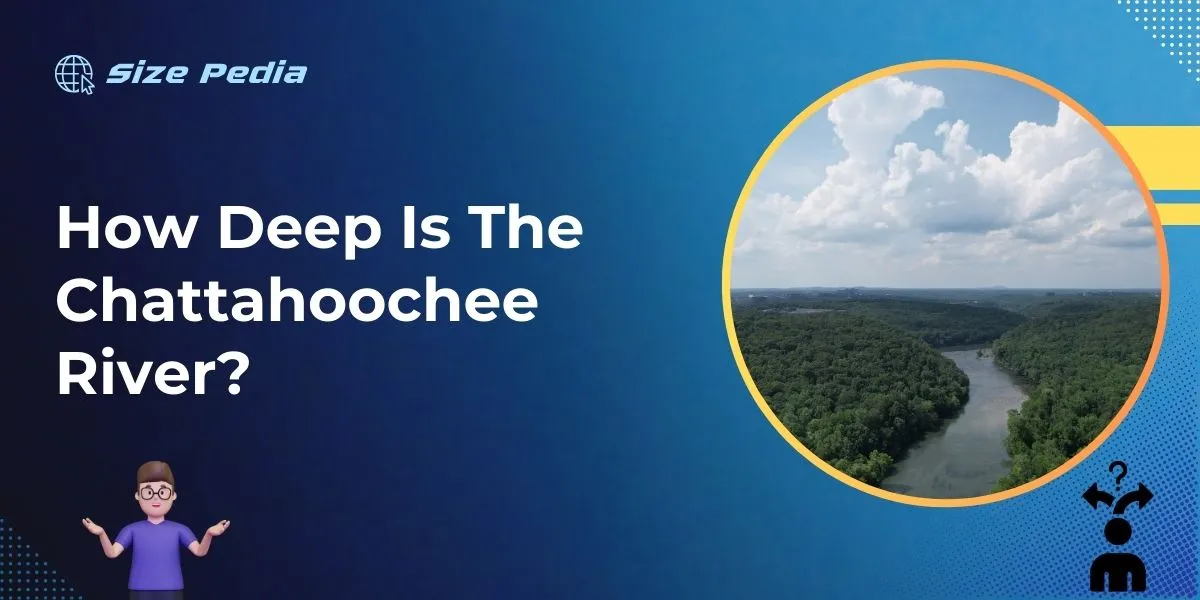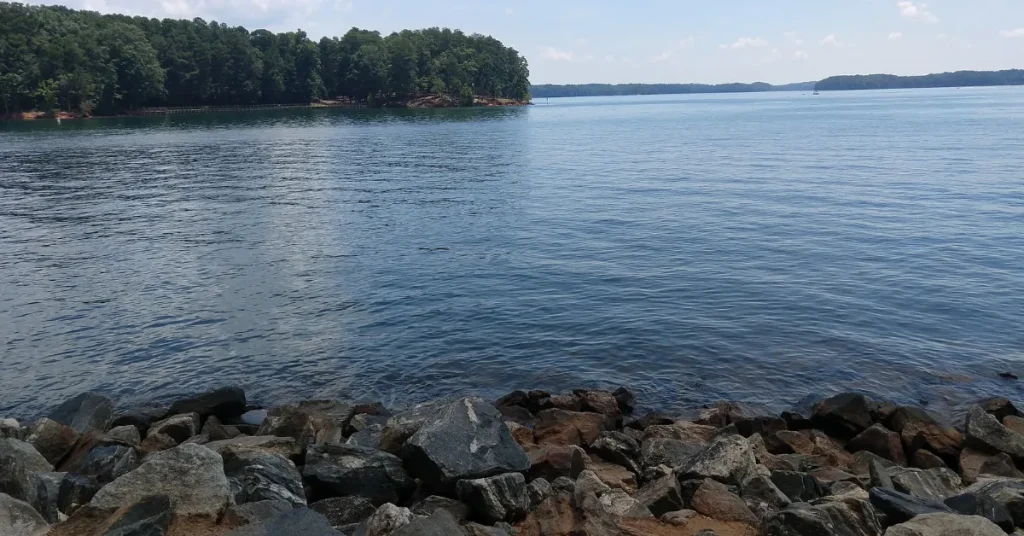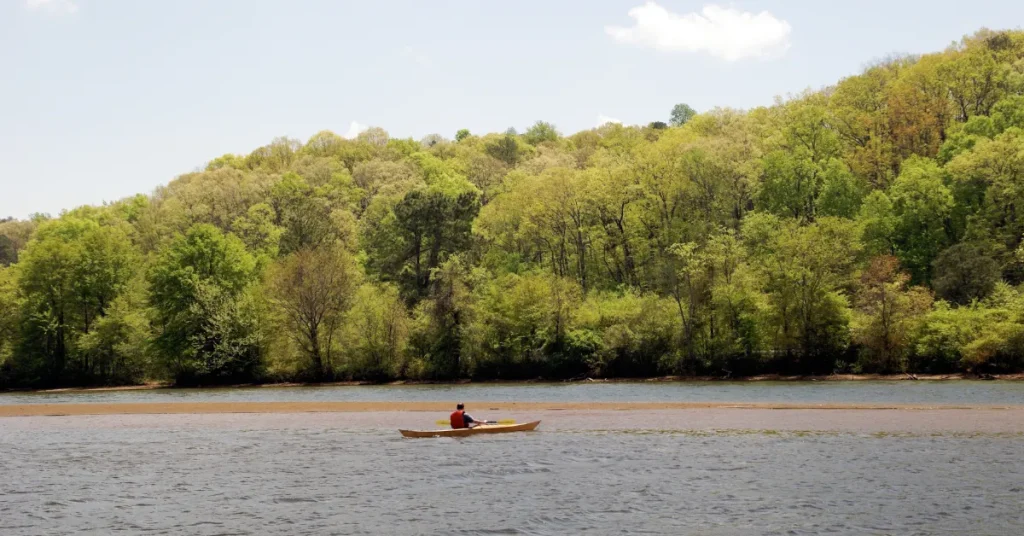The depth of the Chattahoochee River varies greatly, with an average of 5 to 30 feet. It can reach depths of over 100 feet in certain areas.
The Chattahoochee River is a vital waterway that originates in the Blue Ridge Mountains of Georgia and flows southwesterly toward the Gulf of Mexico.
Stretching approximately 430 miles, this river serves as a source of drinking water, recreational opportunities, and habitat for a diverse range of wildlife.
It has played a significant role in the history and development of the region. As it meanders through varying landscapes, the river’s depth changes, influenced by natural features and human-made structures.
The fluctuating depth contributes to the river’s character and challenges for navigators and sports enthusiasts alike.

The Mystique Of The Chattahoochee River
The Chattahoochee River weaves a path through the Southern United States. Its banks hold stories, its waters carry history. Residents and visitors alike find themselves drawn in by its serenity and mystery.
This river is not just a body of water but a living archive of American heritage. The depths of the Chattahoochee are as much about its waters as they are about the depths of its continuing legacy.
Cultural And Historical Significance
The Chattahoochee River holds deep cultural roots. It has provided for many communities. From indigenous peoples to modern cities, it remains central to life in the region.
- Native American Heritage: Once a lifeline for the Creek and Cherokee tribes.
- Civil War Era: The river was a strategic point for both Union and Confederate forces.
- Modern Recreation: Today, it’s a hub for fishing, boating, and relaxation.
Physical Geography And Course
The Chattahoochee River stretches over 430 miles. It rises in the Blue Ridge Mountains and flows southward. Through the heart of Georgia, it heads to the Florida border.
| Source | Blue Ridge Mountains, Georgia |
| Length | ~430 miles |
| Depth | Variable – shallow in places, deeper near dams |
| Course | South through Georgia, to the Florida border |
In its journey, the Chattahoochee reveals its depths. By Atlanta, the depth can be around 5 to 20 feet.
Near Lake Lanier, it gets deeper, thanks to Buford Dam. The river offers tranquil shallows and mysterious depths. These depths support diverse ecosystems and recreational activities.
Measuring The Depths
The Chattahoochee River is a life-giving body of water with its own hidden world beneath the surface. Yet, how deep is this river? To truly understand it, we have to dive into the methods used to measure its depth.
Traditional And Modern Techniques
In the quest to reveal the bottom of the Chattahoochee River, different methods emerge.
- Weighted lines: Once, people dropped heavy ropes to touch the riverbed. This gave a rough depth measure.
- Sonar technology: Boats equipped with sonar send sound waves into the water. The time these take to return tells us the depth.
- GPS mapping: High-tech tools now combine sonar and GPS to create detailed depth charts for the river.
Challenges In Depth Assessment
While measuring the Chattahoochee’s depth, professionals face several hurdles.
| Challenge | Impact |
| River flow | Strong currents can skew sonar readings, making it hard to get accurate measurements. |
| Sediment shifts | The riverbed changes with time, so depth can vary, requiring frequent updates. |
| Accessibility | Some parts of the river are hard to reach, complicating the assessment process. |
Variations Along The River

The Chattahoochee River flows with a life of its own. This river, rich in history and natural beauty, carves its path through the southeastern United States. Its depth varies greatly.
Travelers and locals alike marvel at its dynamic nature. From serene shallow stretches to mysterious deep pockets, the river’s depth can change dramatically. Here, we explore these variations and their causes.
Deep Pockets And Shallow Stretches
Deep pockets in the river invite experienced swimmers and boaters. In some areas, the river reaches depths that exceed 30 feet.
These sections often occur near dams or natural bends in the river’s path. The deepest point, near the Walter F. George Dam, provides an ideal spot for fishing.
Conversely, shallow stretches are a delight for families and casual visitors. They offer safe wading spots and the joy of riverbank picnics. Often less than 2 feet deep, these areas are perfect for a summer day’s splash or skipping stones with friends.
Impact Of Seasons On Water Levels
The seasons bring changes to the Chattahoochee River. Spring thaws and rains often lead to higher water levels.
Plants flourish along the banks, fed by the nourishing waters. River depths can rise significantly during this time, enticing whitewater enthusiasts.
In the fall and winter, water levels tend to drop. Fishermen enjoy the lower levels, revealing more riverbed and calm currents.
This season allows hikers to explore more of the river’s edge. The Chattahoochee’s adaptability across the seasons captivates all who visit its waters.
Human Influence On River Depth
Human Influence on River Depth explores how human activities have shaped the distinctive features of the Chattahoochee River. Over time, changes in the river’s depth have been closely linked to the direct and indirect actions of the local population.
Today, the river’s character stems not only from natural forces. It also arises from the impact of extensive human development and management efforts. Let’s dive into how humans have left their mark on the depths of the Chattahoochee River.
Dams And Reservoirs Effects
The construction of dams and reservoirs is a significant factor that alters the depth of rivers. These structures serve various purposes, including power generation, flood control, and water supply. Here’s how they impact the Chattahoochee:
- Flow Regulation: Dams can greatly change the river’s natural flow. This alteration affects the depth at different sections.
- Depth Increase: Reservoirs typically increase river depth, creating larger bodies of water for storage and recreation.
- Sediment Capture: Dams trap sediments, which may reduce downstream depth over time as less sediment is deposited to maintain the riverbed.
Urbanization And Its Impact
Urban development along the Chattahoochee has also influenced its depth. These changes come from alterations in the landscape and water usage:
- Impervious Surfaces: Cities create lots of hard surfaces. Rainwater runs off quickly, leading to higher peak river flows and potentially deeper channels.
- Water Withdrawals: As cities draw water from the river for human use, the overall depth can decrease, impacting ecosystems and river health.
- Stormwater Management: Effective management can mitigate depth changes. Poor practices can exacerbate the effects of urban runoff.
Exploring The Depths
The Chattahoochee River weaves its way through the southeastern United States, a ribbon of life and leisure. The river’s depth varies significantly as it travels from the North Georgia Mountains, through the heart of Atlanta, and down to the Florida border.
Knowing the actual depths of the Chattahoochee is crucial for both enjoyment and safety.
Recreational Activities And Safety
Outdoor enthusiasts flock to the Chattahoochee for various activities.
- Kayaking and Canoeing: Ideal in shallow parts.
- Fishing: Best in deeper pools where fish congregate.
- Swimming: Safe in designated areas with moderate depths.
Depth knowledge enhances safety for all. It helps prevent accidents in unexpected shallow or deep spots. Here’s a brief outline of depths by activity:
| Activity | Safe Depth Range (Feet) |
| Swimming | 3-6 |
| Kayaking/Canoeing | 2+ |
| Fishing | 4-12 |
Preservation Efforts For Aquatic Life
Keeping the river healthy is vital for aquatic life. The river houses diverse species, many depending on certain depth habitats. Efforts for preservation include:
- Regular water quality testing.
- Conservation programs for native species.
- Educating the public on eco-friendly river usage.
These efforts ensure the balance of the ecosystem for fish and other wildlife. They thrive in clean water with appropriate depth ranges for feeding and breeding.
Understanding and respecting the depths of the Chattahoochee River guarantee a thriving environment for years to come. Enthusiasts enjoy the river’s gifts while contributing to its preservation.
The River’s Future

As we gaze upon the serpentine flow of the Chattahoochee River, a question emerges.
What lies ahead for this vital waterway? Let’s explore how the river might change and what we can do.
Climate Change Predictions
Forecasts suggest significant impacts on the Chattahoochee due to climate change.
Experts foresee fluctuations in water levels. Subtler streams and fiercer floods could become new norms.
- Rising temperatures may lead to altered habitats.
- Erratic rainfall could shift the depth of the river.
- These changes might affect local ecosystems and water quality.
Conservation Strategies
Active conservation efforts are crucial for the river’s well-being.
Strategies must align with the goal of preserving the Chattahoochee for future generations.
- Monitor water quality to detect harmful changes early.
- Restore riparian zones, areas along the riverbanks, to maintain the river’s health.
- Implement sustainable farming practices to reduce runoff into the river.
Collaborative efforts among communities will play a vital role.
Everyone must contribute to the mission of protecting the Chattahoochee.
FAQs About How Deep Is The Chattahoochee River
What Is The Average Depth Of The Chattahoochee River?
The Chattahoochee River’s average depth is approximately 5 to 6 feet. However, depths can vary significantly along its course, from shallow rapids to deeper pools exceeding 30 feet in certain reservoirs.
Where Is The Chattahoochee River Deepest?
The river reaches its greatest depths in the Lake Lanier area, created by the Buford Dam. Here, the Chattahoochee River can plunge to more than 150 feet deep, especially near the dam structure.
How Does The Depth Affect River Activities?
The river’s varying depth influences activities: shallow areas are well-suited for wading and fly fishing, whereas deeper sections are popular for boating and swimming. Always check local guidelines as depth changes can impact safety.
Does The Chattahoochee River Depth Change Seasonally?
Yes, the depth of the Chattahoochee River can change with the seasons. It is typically higher and swifter in the spring due to melting snow and rainfall, while summer and fall usually bring lower and more stable water levels.
Conclusion
Navigating the depths of the Chattahoochee River provides insights into its dynamic nature. With variances from shallow banks to sections over 30 feet, understanding these fluctuations is key for enthusiasts and conservationists alike.
Embracing its mysteries ensures both a respectful enjoyment and a commitment to its preservation.
Explore responsibly and cherish this natural marvel’s depth and diversity.
Resources:
1. https://www.sandyspringsga.gov/chattahoochee-river/
